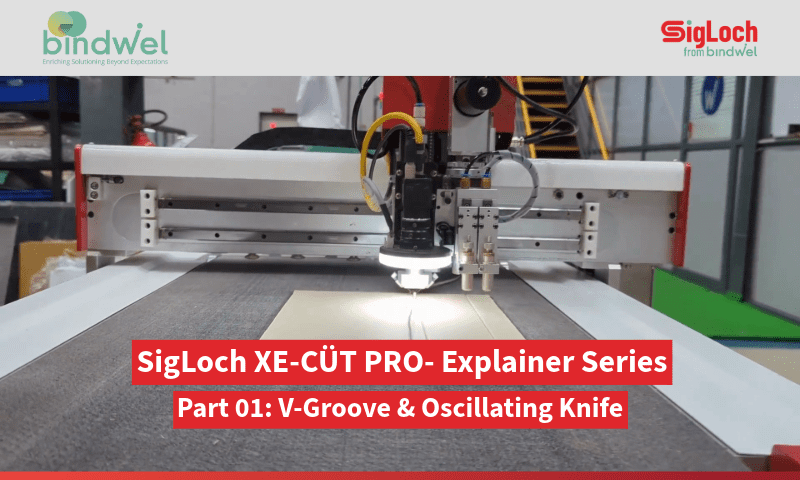One large photo book printer recently contacted me and had several questions in regards to hot-stamping their covers and bound books. Not an easy question to answer. In the age of digital printing, we are dealing with so many new chemicals, coatings and laminating materials. Hot-stamping foil manufacturers have taken these trends into account; and so do the suppliers for laminating foils. Remember: when no conventional laminating foil would stick to digital printed items? But how can you make sure the hot-stamping foil you intend to use or worse, the one your customer requested, will adhere to the substrate? Well, here are some hints from my personal experiences:
Are we able to imprint finished, hard cover bound books?
Yes, as seen during one of my most interesting tours through three large binderies, where these stamping machines were in operation. The Flesher Corp. equipment did imprint flat pieces of covering materials, vertically and horizontally. They imprinted bound books on the front cover and as a first, for many of us, on the spine as well! Incredible, new technologies!
If hot-foil stamping, what materials may be problematic? Have you ever try to count all the different materials used for binding hardcover books?
I’m sure you would agree that this is an impossible task. First, we have many different substrates like paper, cloth, synthetic and extruded materials. Within these categories, there are more varieties like resin reinforced papers, woven cloth grades with different finishes, cotton and polyester mixtures, grains etc. Then we have extruded materials sensitive to heat. Add to that coatings, laminating films – you are expecting miracles! The worst to imprint names must be padded vinyl covers! You assume that all those items can easily be hot-stamped with a single foil? If you have the true answers for all those variables, then you deserve a PhD. in hardcover binding and become a “Book-doctor!”
The very best way to test
Although we will discuss chemical testing procedures, the best tests are still conducting tests with actual samples. At least, this is what I used to do during the many years while working as a sample maker. In a large book manufacturing facility, I was responsible for and furnishing all technical details and measurements for binding. One of those tasks was to pre-test all materials to be hot-stamped, so that we will encounter no problems in the actual production. Just imagine: you blindly follow a book designer’s wishes and purchased large quantities of hot-stamping foils. Then in the actual production run, you find out that they do not work! Guess who will get the blame?
It’s of course always the bookbinder!
What is a Dyne Pen Test?
If you suspect a potential problem, you can always conduct a so-called Dyne Pen test. This is simply testing the surface energy, necessary for UV coated and laminated substrates. These days, printers use many different coatings, matte varnish, gloss varnish, aqueous coatings and yes, several different kinds of film laminates. Printers not always do communicate certain finishing coatings and expect binders to process their particular covering material “as is.” With a Dyne test, we will be able to measure the pores in the surface of a particular coating or foil laminate. This will give us an assurance if a particular ink or a hot-stamping foil will adhere. The test is performed using a series of specifically numbered and formulated pens. The liquid in the pens do measure the ‘dyne’ count of the surface. It is an easy process. Take one of the numbered Dyne pens and draw a line across the surface until the line ‘beads.’ At that point, you will know that the dyne count of the surface is the last line tested before the liquid from the pen beads. A Dyne count of 38 or higher is required for a hot-stamping foil to adhere to the surface. Using this process, you can also test foils, especially critical if you have to over-stamp. For example on Law books, a title in gold over a red panel.
Is this test good enough?
There are arguments that a Dyne test with a pen alone is not enough. These opponents recommend further testing using contact angles, corona treatments and or flame treatments. But talking to hot-stamping experts and my personal experiences in this regard, we found the Dyne pen tests to be sufficient. The other tests are mainly valuable for those who are printing onto film materials like PTFE-Teflon, Polypropylene (PP), Polyethylene (PE) or Polyester (PET). In other words, some of their surfaces need to be modified to be made “process-able.” In our industry, those surfaces most likely have already been modified. As stated, a simple Dyne test will do the trick and make your hot-stamping project a success.
What should we do if the foil still does not adhere?
Always call your foil supplier and ask for technical assistance. Foils are constructed with all kinds of different adhesives (size). A coated paper-like substrate may stamp easily, an extruded, plastic like material may reject the same foil. That is why foil suppliers have different formulations. All that, the foil representative has to do, is to look-up a chart, matching materials to be hot-stamped with an appropriate foil. Again, I hope you do realise, the importance of conducting tests in advance.
Finally, you tried in vain, hot-stamping onto genuine leather and the coverage is not satisfactory. Well, here is another one of the authors tricks – use a foil that is made for edge gilding, it has double the sizing on the back and will do the job. That is what bookbinding is all about, knowing how to successfully cope with virtually every task and those can be many! Welbound is an excellent source to share binding related experiences.





